#Bela lugosi’s dead
Text

Bela Lugosi’s Dead
#bauhaus#peter murphy#the hunger 1983#undead#bela lugosi#Bela lugosi’s dead#david bowie#vampire#1980s goth#batcave#cage#dark wave#trad goth
209 notes
·
View notes
Text
I did some research on Bauhuas for a history of rock course. The information might not be 100% accurate but I’m kinda proud of how it came out. The performance I mentioned is the 2005 Coachella Performance.
In the 70s there was a specific subset of people, known as “bat cavers”. These people would dress up in messy hair known as the “bats nest” and wear black clothes with black on white makeup. These people were also seemingly obsessed with morbid and spooky topics. Today people like this are known as “goths” and the popularity of this subculture can be attributed to the release of 1979’s “Bela Lugosi’s Dead” by post punk band, Bauhaus.
At the time of release post punk wasn’t related to goth people so much as it is today, so one can imagine the public’s shock after hearing this eerie 10 minute track about a dead actor. What made this song so special was the eerie tone of the guitar, strong drum backbeat, distortion, and the morbid theme of the lyrics. This song can be loosely placed into multiple genres, the most striking of these being the reggae genre. When compared to genres surrounding reggae, like 2-tone ska, it becomes more apparent.
This cemented what the post-punk genre would become over the next 40 years. Post release, the song was described as “gothic”, thus sparking the new genre and subset of music culture.
“Bela Lugosi’s Dead”, on the surface, is a ten minute song about a dead actor, specifically, the actor that played Count Dracula in the 1931 film “Dracula”. However, there are multiple ways to look at the lyrics. The most prominent being the description of Bela Lugosi’s burial. Apart from the repeated “Bela Lugosi’s Dead”, there are three lines that outline this exactly. The first line is “the victims have been bled.” This can be seen as the preparation for the burial where the embalmer rids the body of fluids and unnecessary items. “Red velvet lines the black box” is a reference to how Bela’s coffin was lined with red velvet. “The virginal brides file past his tomb” is his visitors walking by his tomb.
However, if you know about goth culture and its origins, there is another meaning to these lyrics. “White on white translucent black capes, back on the rack” can be seen as the commercialization of this sub-culture of people, the same can be said for the line “the victims have been bled” where the victims are the bat cavers who’ve been bled of their culture. “The bats have left the bell tower” is referring to the closing of the old goth club “The Bell Tower” in London and also about the term “bat cavers” “leaving”, or being replaced by the term “goth”.
The performance that I have linked took place at Coachella in 2005. Bauhaus was on stage, shrouded in darkness, and started with the simple drum backbeat. The entire band is dressed in gothic black clothes and the stage is barely lit once the lights come on, adding to the eerienes of the band and its music. The lights come on at the first beat of the drum to reveal Peter Murphy, the vocalist, hanging upside down as if he was a bat. Right off the bat this performance is very gothically inspired. Everyone in the crowd is excited and screaming. At one point the bassist crosses his arms over his chest as if he was Dracula rising out of his coffin. Bauhaus is an excellent example of a post punk band that really took on the gothic themes of the genre.
Thanks for reading! 🖤
#goth aesthetic#bauhuas#bela lugosi#dracula#post punk#reggae#peter murphy#bat cat#bell tower#bela lugosi’s dead#goth#vampire aesthetic#goth music#gothgoth#trad goth#80s goth
69 notes
·
View notes
Text





Bauhaus - “Bela Lugosi’s Dead” (1979)
Forty-five years ago today, on August 6, 1979, the debut single by Bauhaus, “Bela Lugosi’s Dead,” was released. Recorded live in one take on January 26, 1979, it was the first time the four members of the band had recorded together, just six weeks after they had formed. The band would also perform the song in the 1983 erotic horror film The Hunger, and a promotional 7” single of an edited version of the song was delivered to theaters. While the song failed to chart, it is—based on its lyrical imagery and subject matter—generally acknowledged to be the first goth record.
9 notes
·
View notes
Text
I went to Japan and bought this puppet just so I could do this
34 notes
·
View notes
Text

The bats have left the bell tower
5 notes
·
View notes
Text
Bauhaus on a record is absolutely breathtakingly amazing, my soul is leaving my body.
3 notes
·
View notes
Text
Fucking love introducing people to Bela Lugosi’s dead by bauhaus.
The intro is ten million years longer, and people start to get a bit bored, then BAM! verse
Me <3 10 minute songs
4 notes
·
View notes
Text
youtube
Please enjoy this video of Dave Vanian of the Damned dressed as Nosferatu performing Bauhaus' Bela Lugosi's Dead at the Night of a Thousand Vampires
#gerard way#dracula#dave vanian#the damned#bauhaus#bela lugosi’s dead#nosferatu#goth#emo#punk#Youtube
47 notes
·
View notes
Text

The Sorrows of Satan (1926)
Based on Marie Corelli’s 1895 novel of the same name. The picture was famously used as the cover to the Bauhaus single, Bela Lugosi’s Dead (1979).
5 notes
·
View notes
Text

giggles
#yes#vampire sirius black#sheeeeeeeeeeee#this is in fact an homage to the GREAT#STUPENDOUS#BAUHAUS SONG#BELA LUGOSI’S DEAD#/kicking my feet on the bed in excitement
2 notes
·
View notes
Text
FUNNIEST SHIT IVE EVER DONE
5 notes
·
View notes
Text
I don’t know why but when I sit at my desk it clicks and rattles so bad I keep expecting to hear White on white translucent black capes🦇🖤🎶
#chatterbun#Bela Lugosi’s dead#bauhaus#it’s genuinely kind of driving me insane I need to get a screwdriver and fix it 👀
1 note
·
View note
Text

Bauhaus. Bela Lugosi is dead...
#gothic#goth#alternative#goth aesthetic#grunge#aesthetic#horror#dark grunge#goth girl#alt girl#bauhaus#bela lugosi is dead
3K notes
·
View notes
Text




Bauhaus performing "Bela Lugosi’s Dead" in The Hunger (1983)
#the hunger#bauhaus#bela lugosis dead#filmedit#horroredit#musicedit#musicdaily#popularcultures#musicsourcedaily#dailymusicians#blogmusicdaily#musicgifs#80sedit#80sdaily#throwbackblr#usermusic#chewieblog#gothic#my edit#80s#film
11K notes
·
View notes
Text

#Not mine#branson reese#Bransonreese#bela lugosi#bela lugosi's dead#Banging tune#i'm howling#bauhaus
4K notes
·
View notes
Text










Horror movies of the 1930s
#horror#horror movies#horror movie#movie#movies#gifs#gif#horror gif#horror gifs#my gif post#horror edit#horroredit#30s horror#30s#frankenstein 1931#dracula 1931#the invisible man 1933#the invisible man#the black cat 1934#the walking dead#night must fall#j’accuse#the bride of frankenstein#the cat and the canary#the bat whispers#Dracula#frankenstein#boris karloff#claude rains#bela lugosi
200 notes
·
View notes